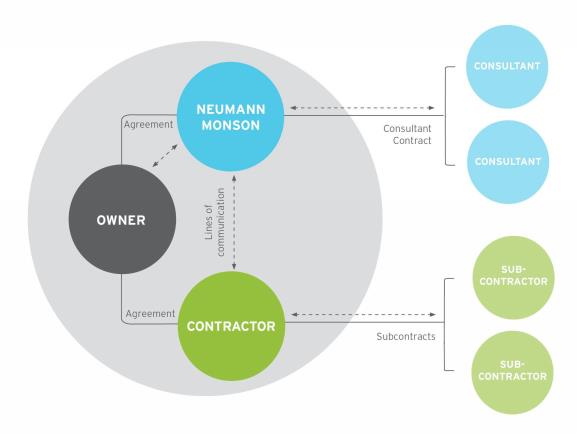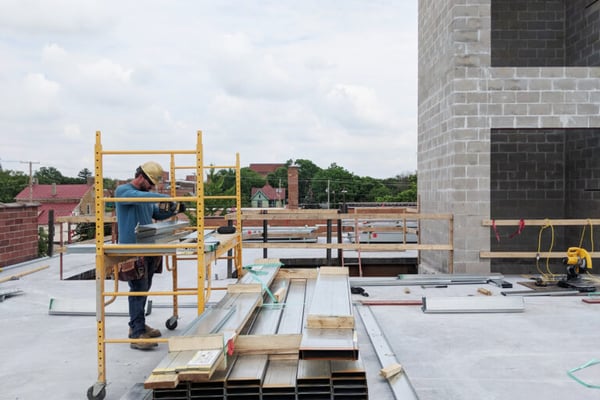We believe the most successful projects occur when the architect plays an active role in construction, and throughout the process, we stay in constant communication with our clients and their contractors. During construction, you can expect your architect to:
- Establish expectations with you and your contractor
- Perform quality control
- Review payments
- Review change orders and handle disputes
- Facilitate Closeout
This article will dive deeper into each of these duties to help you prepare for the process ahead.
Architects as Contract Administrators
Before diving into expectations, we should first explain the role of an architect in construction.
Although most of an architect’s work occurs before construction begins, they stay on the project until completion. During construction, they perform the role of contract administrator by observing the progress and checking that the work matches the design intent outlined in the contract documents.
Additionally, an architect facilitates communication between the contractor and the building owner. Communication flows will differ depending on your project delivery method. For example, if you are using a CM-at-Risk or a CM-Agent delivery method, your Construction Manager may be your primary point of contact.
On most projects, however, you will mostly communicate with your architect.

Typical communication flow between owners, architects, and contractors.
5 Duties of an Architect During Construction
During construction, a quality architect will watch the progress, update you on any changes, and advocate for your interests when items are not in conformance with the contract documents. Specifically, you can expect your architect to perform the following duties:
1. Establish Expectations with You and Your Contractor
Before construction begins, your architect will establish expectations with you and your contractor. Your architect will host a pre-construction kickoff meeting where you will discuss payments, schedules, and lines of communication.
In the kickoff meeting, you may also discuss logistical concerns. For example, if you are undertaking a renovation, you may need to establish boundaries with your contractor so you can continue operating while construction is underway. You may also need to discuss small (but important) details like parking.
The meeting gets everyone on the same page, so the process runs smoothly.
2. Perform Quality Control
Once construction is underway, quality control is your architect’s primary concern. They will visit the site regularly, evaluate the work, and check that the contractor is meeting the design intent. If the design intent is unmet, the architect may reject the work and advise you on your options.
Typically, architects only identify non-conforming work. The owner holds the contract and has the right and authority to order corrections or accept the work.
In addition to visiting the site, your architect will also review submittals from the contractor, including:
- Shop drawings
- Product data
- Certificates
- Warranties
- Color samples
- Mock-ups
Once again, this oversight helps ensure the contractor is meeting the design intent. Although contract documents list acceptable products and manufacturers, the contractor may prefer to use something else. By reviewing submittals, your architect can make help ensure the contractor’s choices align with your vision.

Your architect will visit the site regularly and evaluate the work.
3. Review Payments
Throughout the construction process, your architect will review budgets and payment requests. Typically, you will make monthly payments for the work completed until that point.
Through regular site visits, your architect will review the completed work to help ensure payments to the contractor are accurate. Your architect may advise you to withhold payments for non-conforming work. Once work is corrected, the contractor will be paid in full.
4. Review Change Orders and Handle Disputes
Change orders are a normal part of any building project. When change orders occur, your architect will act as your advisor.
If an unexpected situation arises or your contractor notices an error or omission in the contract documents, they will request clarification from your architect. Your architect will review the request to determine if a change is warranted and if it’s fair and reasonably priced. They may research alternative solutions to make sure you are getting the best value.
They will then discuss the change with you and (with your approval) issue a change order. In these situations, communication needs to flow from the contractor to the architect. Having the architect review all requests before getting your approval helps maintain the design intent and ensures code requirements are met even as the scope changes.
Similarly, if you request a change, discuss it with your architect so they can advise you and communicate the scope change to the contractor.
Disputes
Your architect will also facilitate disputes. In some cases, it may be unclear who should pay, and your architect can help determine whether the contractor is due an additional payment.
Change orders caused by errors or omissions are the building owner’s responsibility. To protect your budget, be sure to set aside a construction contingency.
To learn more, read our guide to errors and omissions and contingencies.
5. Facilitate Closeout
Lastly, your architect will help wrap up construction and get your building ready for move-in. As construction concludes, your architect will evaluate the work and create a “punch list” of items your contractor will need to complete before your move-in date.
They will also review warranties and user manuals to ensure you and your team are trained to operate your facility. Even after you have settled into your new building, your architect will be available to answer any questions. In some cases, your architect will also perform an 11-month walk to help you identify any items that need corrected before the typical one-year contractor’s warranty period expires.
What Are Your Next Steps?
Throughout construction, your architect is your primary point of contact. By facilitating communication, visiting the site, and reviewing change orders, they help maintain the design intent, so you end up with a building that fulfills your goals. A quality architect will stay engaged and communicate regularly, reducing your stress during construction.
Once construction completes, you can start living and working in your new space. Your architect will stay in contact and reach out to perform a post-occupancy evaluation. Read our overview of post-occupancy evaluations to know what to expect.
To learn more about our approach, contact us, and start a conversation with an architect.
